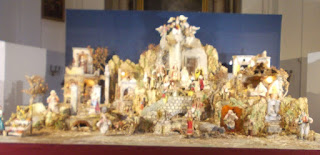School holidays restricted my Rome visit
to August. The heat was tremendous and the crowds crushing. Both my children
suffer health complaints. I was grateful for the churches in Rome. They are
quiet, peaceful places where you can take a minute to admire the beautiful
frescos and friezes.
Here are some of the churches that I
visited in central Rome. Sadly, I didn’t have time to see all.
A page to each church via links give further details.
Basillica di Santa
Maria Maggiore Rome
This
grand church is located in the Piazza Del ‘Esquilino and is the largest church dedicated
to the Virgin Mary. The great sculptor Bernini is buried there.
Read more about the Santa Maria Maggiore here.
 |
| Santa Maria Maggiore's grand interior |
Church of The Gesu,
Rome
This
baroque church is located near the Piazza Venezia and is the mother church of
the Jesuits. Its founder, St Ignatius Loyola, is buried beneath the great altar.
Read more about the Gesu here.
 |
| High altar of the Gesu |
Sant’ Ignazio di Loyola
in Campo Marzio Rome
This
church is named after the Spanish soldier who founded the Jesuit movement. It
can be found in the Via del Caravita.
Read more about Sant' Ignazio di Loyola here.
 |
| Altar within St Ignazio |
Church of San Luigi Dei
Francesi, Rome
Find
this church in the Piazza di S. Luigi de’ Francesi, not far from the Pantheon. It
is the national church of France in Rome and houses art by Caravaggio.
Read more about San Luigi Dei Francesi here.
 |
| Sombre altar of San Luigi Dei Francesi |
Church of Sant’ Agnese
in Agone
Found
in the Piazza Navona, this church is renowned for its elaborate classical concerts.
St Agnes, whom this church is named after, was martyred within the square at
the age of only 13.
 |
| St Agnese in Agone (W Commons) |
Parrocchia Santa Maria
in Portico in Campitelli Rome
Basillica di Sant' Andrea della Valle Rome
This
church is close to the Vittorio Emanuele building. Known also as the Church of
St Andrew of the Valley.
Read more about Sant' Andrea della Valle here.
 |
| Ceiling frescoes of the Sant' Andrea della Valle |
The Church of San
Marcello al Corso, Rome
This
titular church dedicated to Pope Marcellus, nestles within the Via del Corso in
its own little Piazza.
Read more about San Marcello al Corso here.
 |
| The Glowing altar of San Marcello al Corso |
Most
of these churches have superb ceiling frescos, high altars and chapels housing
works by such artists as the students of Bernini, Le Gros, Ludovisi, Rossi,
Raggi and even Caravaggio.
I didn’t get to see the
following churches but wish I had
San Giovanni in
Laterano
The
seat of the pope as the Bishop of Rome, this church is a few years older than
St Peter’s. Both basilicas were built by the first Christian Emperor,
Constantine in the fourth century.
The
Lateral Palace was the abode of popes for 1000 years until moving to Avignon,
then the Vatican.
The
church has suffered looting and damage over the years. But its present grandness
is underscored with giant statures of Jesus, John the Baptist and the apostles
by Borromini. Outside is the tallest obelisk in the world, at 102 feet.
San Paolo Fuori le Mura
St
Paul’s basilica is the largest in Rome (bar St Peter’s). Built by Constantine,
it was destroyed by fire, but restored in the mid 18th century.
Admire the huge Byzantine doors dating from the 11th century. The
high altar is said to be the resting place of St Paul the apostle after being
beheaded. Admire the Benedictine cloister by Vassalletto and the elegant
columns enclosing a garden.
San Clemente
This
church hides a fascinating history. It dates from the 12th century
with 3 naves divided by columns and pavement of geometric mosaic designs. View
the Tree of Life mosaic in the apse. A 4th century basilica can be
found down a staircase where Romanesque frescoes can be found. An even deeper
staircase leads to chambers believed to be where St Clemente lived. He was
martyred by Hadrian in 88AD. An earlier pagan temple exists on the site.
San Petro in Vincoli
Near
Piazza Cavour, this church was founded in the 5th century on the
site of where St Peter was tried and sentenced. Michelangelo’s greatest sculptures,
Moses, are housed here. It was intended for St Peter’s basilica, being one of
40 figures to adorn a tomb. But the then emperor Julius II decided Michelangelo
should paint the Sistine Chapel instead. On each side, find sculptures of
Rachel and Leah.
Reference: Berlitz
Pocket Guide to Rome (2016)
Church publications



















































